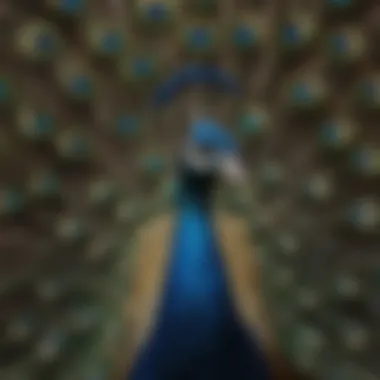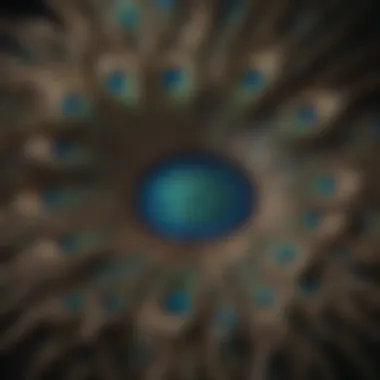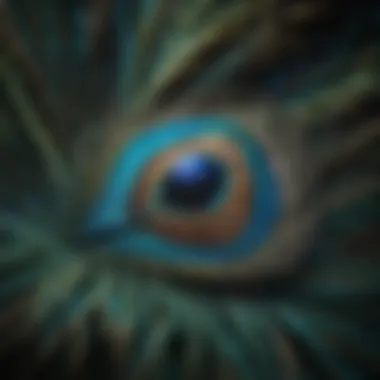Unveiling the Enigmatic Symbolism of the Peacock Across Cultures


Animal Species Profile
The captivating peacock, a majestic avian species, has enthralled cultures worldwide with its dazzling plumage and graceful demeanor. Originating from diverse habitats, peacocks are renowned for their stunning physical characteristics, notably their iridescent feathers with striking hues that symbolize beauty and vibrancy. These birds are predominantly found in Asia, including regions like India, Sri Lanka, and Myanmar, where they roam freely in lush forests and open grasslands. Known for their vocal calls and elaborate courtship displays, peacocks exhibit intriguing social behaviors, forming bonds within their communities.
Symbolism and Cultural Significance
Throughout history, the peacock has served as a symbol of grandeur, beauty, and spirituality across various cultures and belief systems. In Hindu mythology, the peacock is associated with the goddess Saraswati, representing wisdom, enlightenment, and learning. Similarly, in Greek and Roman mythology, the peacock is linked to deities like Hera and Juno, symbolizing immortality and protection. The peacock's regal appearance has often been depicted in art, literature, and religious contexts, signifying themes of royalty, resurrection, and divine guidance.
Modern Interpretations and Iconography
In contemporary contexts, the peacock continues to inspire artists, designers, and thinkers with its intricate patterns and striking visuals. From fashion runways to interior décor, the peacock motif has found its place as a symbol of opulence and luxury, reflecting a fusion of tradition and modern aesthetic sensibilities. Moreover, the symbolism of the peacock extends to marketing and branding, where its association with beauty, pride, and allure is leveraged to create impactful visual identities and advertising campaigns.
Conclusion: Navigating Symbolic Depths
Exploring the symbolism of the peacock unveils a profound tapestry of meanings that transcend time and cultural boundaries. From ancient mythologies to contemporary interpretations, the peacock's symbolism resonates with themes of beauty, spirituality, and resilience, offering a nuanced understanding of its symbolic significance in human consciousness. Embracing the diverse facets of peacock symbolism allows us to delve deeper into the complexities of symbolism, art, and cultural legacy, inviting us to appreciate the enduring allure of this majestic bird.
Introduction
Brief Overview of the Peacock
In providing a brief overview of the peacock, one must acknowledge its status as a symbol of beauty, grace, and vibrancy in the animal kingdom. The peacock's iridescent feathers and majestic demeanor have captivated human imagination for centuries, making it a prized representation in various cultural and spiritual contexts. Beyond its physical allure, the peacock symbolizes attributes such as integrity, protection, and enlightenment in different belief systems worldwide. This section will delve into the historical roots and cultural significance of the peacock, unveiling the layers of symbolism that give this bird its timeless appeal.
Historical Symbolism
In this article, we delve into the essential aspect of Historical Symbolism surrounding the majestic peacock. Historical Symbolism plays a crucial role in understanding the deeply rooted meanings and significances attributed to the peacock throughout various civilizations and time periods. By examining how the peacock symbolizes different concepts and virtues across history, we gain insights into the evolution of cultural interpretations and beliefs.
Peacock Symbolism in Ancient Civilizations
Mesopotamian Symbolism


Mesopotamian Symbolism holds a significant place in the legacy of the peacock's symbolism. This ancient civilization associated the peacock with symbols of royalty, protection, and immortality. The intricate Mesopotamian artwork depicting peacocks emphasized their regal status and connection to deities, reflecting the cultural reverence for these birds. The choice to incorporate Mesopotamian Symbolism in this article adds a unique dimension to our exploration of the peacock's symbolism, showcasing diverse cultural perspectives.
Egyptian Symbolism
The symbolism of the peacock in ancient Egypt was deeply intertwined with themes of rebirth, resurrection, and the cycle of life. Egyptians revered the peacock for its association with the sun god Ra and the goddess Hathor, symbolizing vitality and cosmic beauty. The captivating imagery of peacocks in Egyptian art and mythology underscores their profound spiritual significance, making Egyptian Symbolism a poignant inclusion in our analysis of the peacock's symbolic meanings.
Greek and Roman Symbolism
Greek and Roman civilizations interpreted the peacock as a symbol of immortality, protection, and the all-seeing eyes of the gods. In Greek mythology, the peacock was linked to the goddess Hera, representing her watchful gaze and divine protection. Among Romans, the peacock embodied themes of eternal life and heavenly vision. Exploring Greek and Roman Symbolism adds a classical perspective to our understanding of the peacock's symbolism, enriching our discourse with insights from ancient Western cultures.
Indian Symbolism
In Indian symbolism, the peacock holds multifaceted meanings symbolizing immortality, benevolence, and protection. Peacocks are revered in Hindu and Jain traditions for their association with gods and goddesses, symbolizing purity and auspiciousness. The elaborate depictions of peacocks in Indian art and religious ceremonies underscore their sacred symbolism. By incorporating Indian Symbolism into our exploration, we illuminate the diverse cultural interpretations of the peacock across different belief systems, offering a comprehensive portrayal of its symbolic significance.
Cultural Representations
Peacock symbolism in different cultures plays a vital role in highlighting the rich tapestry of meanings associated with this magnificent bird. Understanding the cultural representations provides a profound insight into the diverse interpretations and values attached to the peacock. Cultural representations serve as a lens through which we can appreciate the significance of the peacock in various societal contexts.
Peacock Symbolism in Different Cultures
Chinese Culture
In Chinese culture, the peacock is a symbol of beauty, dignity, and good fortune. Its vibrant colors and elegant appearance symbolize prosperity and harmony. The peacock is often associated with the goddess Kuan Yin, representing compassion and purity. The inclusion of peacock motifs in traditional Chinese art and artifacts signifies auspiciousness and rejuvenation. The representation of the peacock in Chinese culture adds a layer of sophistication and grace to the overall symbolic significance.
Japanese Culture
Japanese culture views the peacock as a symbol of integrity, immortality, and renewal. The peacock's regal presence and symbolic association with longevity make it a revered figure in Japanese folklore and art. The intricate patterns of the peacock's feathers inspire creativity and attention to detail in various artistic expressions. The peacock's essence in Japanese culture embodies resilience and the cyclical nature of life, reflecting a deep appreciation for beauty and impermanence.
Islamic Culture


In Islamic culture, the peacock symbolizes guidance, protection, and spirituality. The peacock's symbolism is rooted in Sufi mysticism, where its magnificent plumage represents the divine beauty and transcendence of the soul. Islamic art often features peacock motifs to evoke themes of eternity and watchfulness. The peacock serves as a reminder of the intricate connection between the material and spiritual realms, offering contemplative symbolism in Islamic artistic and cultural expressions.
Native American Culture
Within Native American culture, the peacock symbolizes vision, wisdom, and integrity. The peacock's symbolism is intertwined with themes of foresight and clarity of vision. Native American traditions integrate the peacock as a symbol of guidance and protection, reflecting respect for nature's wisdom and inherent harmony. The peacock's representation in Native American culture exemplifies a holistic approach to spirituality and interconnectedness with the natural world, enriching the cultural landscape with its symbolic profundity.
Symbolic Meanings
In this comprehensive exploration of the symbolism surrounding the magnificent peacock, we uncover a tapestry of interpretations that have transcended time and cultures. The symbolic essence of the peacock extends far beyond its physical beauty, delving into realms of immortality, beauty, wisdom, protection, and guidance. Each layer of symbolism woven into the peacock's depiction adds depth and complexity to its representation across various belief systems and mythologies.
Key Symbolic Meanings of the Peacock
Immortality and Renewal
The notion of immortality and renewal epitomizes the peacock's symbolism, symbolizing eternal life and the cyclical nature of existence. As we delve into this aspect, we discover the peacock's ability to shed and regrow its magnificent plumage, mirroring the eternal cycle of life, death, and rebirth. This symbolism not only captivates the imagination but also provides a profound commentary on the ongoing renewal inherent in the natural world.
Beauty and Vanity
Within the realm of beauty and vanity, the peacock stands as a beacon of aesthetic excellence and allure. Its resplendent feathers have captivated human fascination for centuries, symbolizing not only physical beauty but also the allure of vanity. This aspect prompts contemplation on the dual nature of beauty – both captivating and transient, inviting reflection on the nature of perception and self-admiration.
Wisdom and Knowledge
The peacock's symbolism of wisdom and knowledge transcends its ornamental display, symbolizing an extension of profound insight and intelligence. In various cultures, the peacock's regal posture and piercing gaze represent the pursuit of knowledge and enlightenment. This symbolism encourages us to seek wisdom beyond the superficial, reminding us that true knowledge lies not in appearance but in the depth of understanding.
Protection and Guidance
The peacock's symbolism of protection and guidance stems from its role as a guardian in folklore and mythology. Throughout history, the peacock has been revered as a protector against evil forces, its majestic appearance believed to ward off negativity. This aspect of the peacock's symbolism offers reassurance and guidance, depicting it as a symbol of safety and safeguarding in times of uncertainty.
Literary and Artistic Representations


Literary and Artistic Representations play a pivotal role in decoding the symbolism of the majestic peacock 🦚. In the context of this article, delving into the representation of the peacock in literature and art unveils layers of nuanced meanings and interpretations that enrich our understanding of this vibrant bird. By scrutinizing the peacock's portrayal in written works and visual art forms, we gain insight into the diverse symbolisms attached to it throughout history and across cultures.
Peacock Symbolism in Literature
The depiction of peacocks in literature spans a spectrum of symbolisms and allegories. From ancient texts to modern writings, authors have employed the peacock as a symbol of beauty, pride, and transformation. In Indian literature, the peacock often symbolizes love, courtship, and fertility, reflecting its cultural significance in the region. In western literature, the peacock is frequently used to represent vanity and extravagance, highlighting different cultural perceptions of this enigmatic bird.
Peacock Imagery in Art
Peacock imagery in art holds a unique place in the realm of visual representations. Artists across history and geographies have been fascinated by the peacock's iridescent plumage and regal demeanor, incorporating its imagery into various art forms. From ancient mosaics to Renaissance paintings and contemporary installations, the peacock's vibrant colors and intricate patterns have inspired awe and admiration. The depiction of peacocks in art often symbolizes beauty, grace, and auspiciousness, transcending mere aesthetic appreciation to convey deeper symbolic meanings.
Modern Interpretations
In delving into the modern interpretations of peacock symbolism, one uncovers a fascinating realm of contemporary perspectives that shed light on the enduring relevance of this majestic bird. The significance of modern interpretations within the broader context of exploring symbolism is paramount, as it offers a fresh lens through which to analyze age-old representations. By focusing on the specific elements that define modern interpretations, we can appreciate the nuanced connections between tradition and innovation, folklore and psychology.
Contemporary Views on Peacock Symbolism
Psychoanalytic Interpretations
Exploring the realm of psychoanalytic interpretations unveils a deep psychological interplay embodied by the symbolism of the peacock. This specific aspect delves into the subconscious layers that the peacock represents, unraveling themes of ego, pride, and self-awareness. The key characteristic of psychoanalytic interpretations lies in its ability to decipher hidden meanings behind the vivid symbolism, offering profound insights into human behavior and societal constructs.
This choice for the article proves beneficial due to the intricate parallels it draws between the external representation of the peacock and internal psychological landscapes. The unique feature of psychoanalytic interpretations lies in its capacity to decode complex symbols and reveal underlying motives, enriching our understanding of the peacock's symbolic tapestry. However, the potential drawback of this approach may lie in its propensity to exude complexity, potentially alienating readers seeking a more straightforward analysis.
Environmental and Conservation Perspectives
Discussing the environmental and conservation perspectives surrounding peacock symbolism sheds light on the intertwined relationship between culture, nature, and sustainability. This aspect emphasizes the peacock's ecological significance, highlighting the need for conservation efforts to preserve not only a symbol but a living species. The key characteristic of environmental and conservation perspectives underscores the urgency of promoting environmental awareness and advocating for the protection of biodiversity.
The choice of including this perspective in the article serves as a reminder of the interconnectedness between symbolism and real-world implications. The unique feature of environmental and conservation perspectives lies in its ability to prompt action and instigate change, bridging the gap between abstract symbolism and tangible conservation measures. Nonetheless, a potential disadvantage of this focus could be the deviation from purely symbolic discourse towards a call for practical interventions, straying slightly from the thematic core of abstract symbolism.
Conclusion
Peacocks symbolize various virtues across cultures. Understanding their symbolism is crucial in appreciating the depth of human interpretation of nature. The multifaceted symbolism of the peacock reveals layers of complexity that enrich our understanding of cultural and religious beliefs. By exploring the peacock's significance throughout history and in various contexts, we gain insights into the evolution of symbolisms and their enduring impact on societies.
Summarizing the Multifaceted Symbolism of the Peacock
Peacock symbolism embraces diverse themes from immortality to beauty, wisdom, and protection. In ancient civilizations like Mesopotamia, Egypt, Greece, Rome, and India, peacocks represented immortality, protection, and divinity. The intricate designs of peacock feathers captured the essence of beauty and vanity in Chinese and Japanese cultures. In Islamic and Native American beliefs, peacocks embody divine wisdom and guidance. The contemporary world sees peacocks through psychoanalytic and environmental lenses, symbolizing psychological depths and conservation efforts.
The symbolism of the peacock transcends time and space, weaving a tapestry of meanings that resonate with each culture's unique interpretations. By delving into the symbolisms attached to the peacock, we unearth deeper truths about human perception, spirituality, and creativity.







